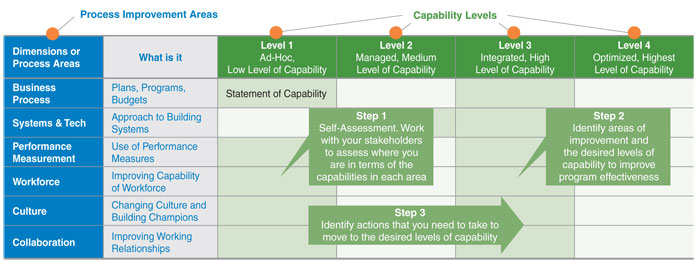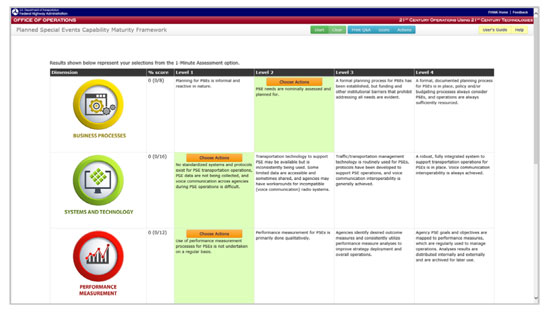Planned Special Event Capability Maturity Framework
FACTSHEET
FEBRUARY 2016
Download the Printable Version (PDF, 2.0MB)
PDF files can be viewed with the Acrobat® Reader®.
Background
The concept of a capability maturity framework (CMF) emerged from the Strategic Highway Research Program 2 (SHRP2) L01 and L06 projects that promoted a process-driven approach to improve Transportation Systems Management and Operations (TSM&O). Adapted from the software development world, the notion of CMFs rests on the following three tenets:
- Process matters: Projects fail or do not achieve desired functionality for a variety of reasons unrelated to the technology.
- Prioritizing the right action is important: Is an agency ready, how do they know, and what should they do next?
- Focus on the weakest link: What is holding the agency back in becoming a leader in a particular area?
Building on SHRP2 results, the American Association of State Highway and Transportation Officials (AASHTO) has continued development of this concept and a capability maturity concept was published as part of the TSM&O guidance. SHRP2 implementation activities have successfully used the overall framework to work with State DOTs to develop action plans to improve their TSM&O capabilities.
To continue the emphasis on capability maturity and to provide program-level guidance, Federal Highway Administration (FHWA) developed additional
frameworks that focus on improvement actions for specific TSM&O program areas including:
- Traffic Management
- Traffic Incident Management
- Road Weather Management
- Planned Special Events
- Work Zone Management
- Traffic Signal Management
These frameworks are designed for agencies and regions to assess the current strengths and weaknesses and develop a targeted action plan for the
program area.
More details can be found of the FHWA Operations web site: https://ops.fhwa.dot.gov/tsmoframeworktool/index.htm.
Table 1. Capability Maturity Framework Process Overview

Planned Special Event Capability Maturity Framework
Planned special events (PSEs) include sporting events, concerts, festivals, and conventions occurring at permanent multi-use venues (e.g., arenas, stadiums, racetracks, fairgrounds, amphitheaters, convention centers). They also include less frequent public events such as parades, fireworks displays, bicycle races, sporting games, motorcycle rallies, seasonal festivals, and milestone celebrations at temporary venues.
PSEs can significantly impact travel safety, mobility, and travel time reliability across all surface transportation modes and roadway facilities. Managing travel for PSEs involves advanced operations planning, stakeholder coordination and partnerships, developing a multi-agency transportation management plan, raising awareness of the general public and event patrons of potential travel impacts, and coordinating agency services and resource sharing.
Use of the framework is recommended when the agency or region is considering improving existing planning activities and protocols for PSEs, or if the region has a new or major upcoming PSE that is expected to have significant impacts.
In all these instances, the use of the framework will provide a structured approach to review the complex institutional architectures and business processes required to make PSE management a success. By reviewing the "non-technical" issues in detail and implementing the prioritized actions, agencies will increase the capability and sophistication of their management of special events.
Structure
Consistent with the SHRP2 guidance, the frameworks are all described as a matrix that defines the process improvement areas and levels (from Level 1, low-level to Level 4, optimized high-level) of capability. Following a self-assessment process, specific actions are identified to increase capabilities across the desired process areas. Capabilities are described for the following six areas:
- Business processes
- Systems and technology
- Performance measurement
- Organization and workforce
- Culture
- Collaboration
Using the Framework
A Planned Special Event Management CMF and a supporting interactive tool have been developed. The current version of the framework is available at
https://ops.fhwa.dot.gov/tsmoframeworktool/available_frameworks/planned_events.htm.
A collaborative process is recommended for using the CMFs for any program area. Typically, a local agency champion will pull together stakeholders for a day-long workshop to walk through the framework. PSE stakeholders may include event coordinators or managers, select groups of event planners, law enforcement representatives, and traffic managers in the region. The outcomes of the workshop are a consensus of the current capabilities across all the dimensions and an initial list of prioritized actions.
The champion might then convene future meetings or identify existing forums where the identified actions will be championed and implemented.
The framework is not intended as a benchmarking tool, but rather as a resource for agencies to identify appropriate actions for improving management and operations of planned special event management. While periodic assessments are not required, revisiting the tool is recommended when significant organizational change occurs or prior to major investments in the area.

Figure 1. Screenshot of Tool
Get involved:
If interested in using the framework, or hosting a CMF workshop for your agency or region, please contact: Operations Feedback at OperationsFeedback@dot.gov.
FHWA-HOP-16-030
FEBRUARY 2016